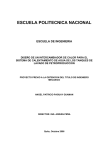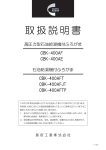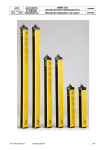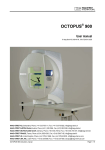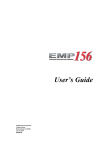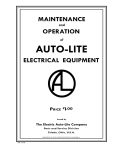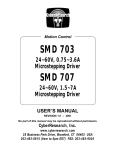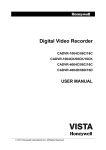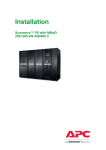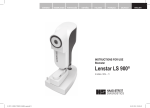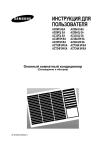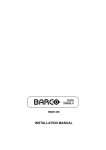Download OCTOPUS 900 Service Manual - Haag
Transcript
OCTOPUS 900 Service Manual ©HAAG-STREIT 06/2009 HS No. 7220054 Revision 02 HAAG-STREIT AG, Switzerland, Phone: +41 31 978 01 11, Fax: +41 31 978 02 82, [email protected] HAAG-STREIT DEUTSCHLAND GmbH, Germany, Phone: +49 4103 709 02, Fax: +49 4103 709 370, [email protected] HAAG-STREIT FRANCE, France, Phone +33 4 5009 0033, Fax +33 4 5009 7190, [email protected] HAAG-STREIT UK, United Kingdom, Phone +44 1279 414969, Fax +44 1279 635232, [email protected] HAAG-STREIT USA, INC., USA, Phone: +1 513 336 6858, Fax: +1 513 336 7828, [email protected] OCTOPUS 900 Service Manual HAAG-STREIT No. 7220054 TABLE OF CONTENTS 1 ITEMS SUPPLIED ..........................................................................................................................................................................3 2 SAFETY INSTRUCTIONS..............................................................................................................................................................4 2.1 General.................................................................................................................................................4 2.2 Ambient conditions ...............................................................................................................................4 2.3 Power Connection ................................................................................................................................4 2.4 Instrument Transportation ....................................................................................................................4 2.5 Special Notices in the Text...................................................................................................................5 2.6 Symbols on Display ..............................................................................................................................5 INTRODUCTION ............................................................................................................................................................................6 3.1 OCTOPUS Perimeter 900....................................................................................................................6 3.2 Octopus 900 control unit / PC ............................................................................................................11 WARRANTY AND PRODUCT LIABILITY ...................................................................................................................................12 4.1 Statutory requirements .......................................................................................................................12 4.2 Type plate...........................................................................................................................................13 4.3 Pictogram symbols .............................................................................................................................13 4.4 Support stand .....................................................................................................................................14 4.5 Safe system configuration in accordance with IEC / EN 60601-1 ......................................................15 4.6 Installation ..........................................................................................................................................19 INSTALLATION AND USAGE OF EYESUITE PERIMETRY SOFTWARE .................................................................................20 5.1 Installation, Exchange, Upgrade ........................................................................................................20 5.2 Releasing Program Options ...............................................................................................................21 PRINCIPLE OF OPERATION.......................................................................................................................................................22 6.1 Stimulus Intensity Control...................................................................................................................22 6.2 Current Control...................................................................................................................................22 6.3 Background Intensity Control .............................................................................................................23 6.4 Reference Point..................................................................................................................................23 6.5 Optics Module ....................................................................................................................................24 MAINTENANCE & REPAIR .........................................................................................................................................................25 7.1 Cleaning .............................................................................................................................................25 7.2 Housing ..............................................................................................................................................26 7.3 Power supply unit (1803900)..............................................................................................................28 7.4 Processor module (1804005) & Light controller board (1804205) .....................................................30 7.5 Camera module (1803800) ................................................................................................................32 7.6 Stimulus Projector (1803400) & Projector–fixation target (1803600).................................................36 7.7 Brightness measurement p.c.b. - stimulus (1804421) .......................................................................44 7.8 Aperture-/filter-module (1803500) ......................................................................................................45 7.9 LED Board - stimulus (1804525) ........................................................................................................46 7.10 Refractive lens holder module (1803250) ..........................................................................................47 7.11 Mirror Unit (1803300) ........................................................................................................................50 7.12 Headrest (1803200) ...........................................................................................................................51 7.13 Operating unit (1803170) ...................................................................................................................52 7.14 IR illumination (1803550) ..................................................................................................................53 7.15 Brightness measurement p.c.b. - background (1804421)..................................................................53 7.16 Background illumination (1803570)....................................................................................................54 SYSTEM MESSAGES..................................................................................................................................................................55 8.1 Messages (to be completed in revision 2)..........................................................................................55 8.2 Errors (to be completed in revision 2) ................................................................................................55 8.3 Resetting the IP address ....................................................................................................................59 APPENDIX....................................................................................................................................................................................60 9.1 Technical specifications .....................................................................................................................60 9.2 Instrument OCTOPUS 900 ................................................................................................................60 3 4 5 6 7 8 9 Page 2 / 53 HAAG-STREIT 08.06.09 1 ITEMS SUPPLIED We congratulate you on choosing the OCTOPUS 900 – 90° visual-field perimetry of the latest generation. Depending on your order, the items supplied are as follows: − OCTOPUS 900 − Accessory kit − optional support stand Please check the delivery with care 1 x OCTOPUS Perimeter 900 1803000 1 x accessory kit, consisting of: 1 x patient-response button 1802439 1 x Ethernet switch 100Mbps 1803090 2 x Ethernet cable 1803094 1 x dust cover 1803061 1 x instruction manual 7220031 1 x CD with all Octopus 900 and EyeSuite Perimetry manuals 7220030 1 x eye occluder set 1802349 2 x spare fuses (T3.15 A / 250 V) 3000481 1 x support stand, consisting of: 1 x stand base 1801187 1 x O-900 table top 1803051 1 x set of accessories for support stand 1801194 1 x Visual Field Digest 1800092 Please keep all packaging material, as this can be reused for possible returns or when relocating. OCTOPUS 900 Service Manual Page 3 / 61 2 SAFETY INSTRUCTIONS 2.1 General • This instrument should only be used for the purpose as described in this manual. • Condensation can occur on the cold surfaces of the instrument if it has been transported from a cold environment to the environment in which it will be used. In such a case, one should wait a couple of hours before turning on the instrument. Once the temperature of the instrument is the same as the environment in which it has been placed and once it is dry you may proceed with powering on the instrument. • The examination of the patients, the operation of the instrument and the interpretation of the results can only be performed by persons who are experienced and who have been trained accordingly. • The instrument is to be installed on the height-adjustable table and employed in a dimly lit room in a medical area. • Keep the service manual there where persons who have been trained to repair the instrument can consult it at all times. Guarantee claims can only be valid when the instructions in the service and user manuals are followed. • The doctor or operator is to instruct the patient in the safety instructions and check that they are observed. • Make sure that the instrument is connected only to the power source as defined on the perimeter rating plate. The on/off switch does not separate the perimeter from the power lines. Before maintenance or cleaning work is performed, the power cord must be removed from the wall socket. • The instrument should not be used in an explosive area. Do not store any flammable and explosive substances (such as Alcohol, Petrol, Gas) near the instrument. • Removal of the housings and repairs to the instrument are permitted only by trained and authorized technicians. Considerable danger for the operator and patients can be caused by improper repairs. • The dust-cover should be removed before turning on the instrument. If this is not done the light sources may get damaged due to overheating. On the other hand make sure that the instrument has been switched off before covering it with the dust-cover. • Only original replacement parts and original accessories are permitted for repairs. 2.2 Ambient conditions • Transportation • Storage • Working Temperature Air pressure Relative Humidity Temperature Air pressure Relative Humidity Temperature Air pressure Relative Humidity -40°C 500hPa 10% -10C 700hPa 10% +10°C 700hPa 20% to to to to to to to to to +70°C 1060hPa 95% +55°C 1060hPa 95% +40°C 1060hPa 75% Environment • Electric and electronic equipment must be separated from house waste! This equipment has been introduced into the market after the 13th of August 2005. • Disposal via your local collecting point or your Haag-Streit distributor. • Thus it is ensured, that no harmful materials get into the environment and that valuable raw materials can be reused again. 2.3 Power Connection • Only use a conformed power cable. To reduce the risk of an electro shock, ensure that the power cable and plug is connected with an earth lead. • The cable, plug and ground connection on the wall socket must be 100% functional. 2.4 Instrument Transportation Transport the instrument over large distances in the original packing. For short distances the instrument can be lifted by placing the cupola towards ones chest, then place both hands behind the cupola (bottom section) and lift the instrument. See user’s manual section 4.5.2. Page 4 / 61 OCTOPUS 900 Service Manual 2.5 Special Notices in the Text Further safety instructions are put into the text as needed. They vary in importance and should help reduce risks for the patient and operator, avoid damage to the perimeter and insure optimal functioning. ! ATTENTION Instruction which must be followed to reduce risks to the patient and operator. Warning Instruction which must be followed to avoid damage to the perimeter. Tip Tip for insuring optimal functioning of the perimeter. All OCTOPUS 900 functions are mentioned in this service manual. Certain functions are offered as options and there is a possibility that they are not installed/ supplied with the instrument. 2.6 Symbols on Display 2.6.1 Messages, Errors Error and warning messages OCTOPUS 900 Service Manual Page 5 / 61 3 INTRODUCTION 3.1 OCTOPUS Perimeter 900 The OCTOPUS 900 is an automatic projection perimeter for the examination of the whole field of sight (90°). The system is divided into an examination element (OCTOPUS 900) and a control unit (notebook computer or PC). The examination element communicates with the external PC via an Ethernet link. The OCTOPUS 900 is controlled using the software installed on the PC. The perimeter may be controlled, if required, from a fully-lit adjacent room. The integrated, automatic patient-fixation control function guarantees the reliability of diagnosis. The OCTOPUS 900 is suitable for both clinical and investigational purposes, as its flexibility is virtually unlimited. Thanks to its spherical, Goldmann-type cupola design, the OCTOPUS 900 tests the entire field of sight (up to 90° eccentricity). The flexibility of this appliance allows it to deal with all perimetry tasks, both in the 30° and 90° range, using kinetic, static or flicker perimetry. New PC and perimetry software can be downloaded and updated by going to www.octopus.ch. Page 6 / 61 OCTOPUS 900 Service Manual Components 1 2 3 4 5 6 7 8 1 2 3 4 5 6 7 8 9 10 11 12 13 Top cover for stimulus projector Front cover Housing / Cupola Mirror unit cover Forehead rest Display Keypanel Refractive lens holder with IR eye illumination and refractive lenses Chinrest Response button Response button connector Type plate Table height adjustment 9 10 11 12 13 Fig. 3-1 * 14 15 LCD display The high-contrast TFT colour display allows the video image to be viewed from an oblique angle. The following messages are displayed on-screen: 16 14 Indication of a '' during stimulus presentation. 15 Indication of an '', if the patient-response button is pressed. 16 The crosshairs help to centre up the eye, scale = 1mm intervals. 17 Display of left (OS) or right eye (OD) 18 Warning or error message 18 17 OD Fig. 3-2 OCTOPUS 900 Service Manual Page 7 / 61 19 22 20 Control panel The control panel consists of an easy-to-use keypad made of soft but hard-wearing rubber material. All buttons are backlit with white light to facilitate their use in a darkened room. The backlighting can be disabled, if required, by adjusting the display brightness settings. 21 19 20 21 22 Turning the refractive lens holder in and out Display brightness settings Adjustment of chin support Start examination see Fig. 3-4 24 25 26 Connections Fig. 3-3 27 23 24 25 26 27 Plug-in mains power unit Mains switch Holder for two T3.15AL/250V fuses Mains connection Ethernet connection 23 Fig. 3-4 DANGER Page 8 / 61 All externally connected appliances and items of equipment must conform to the relevant safety standards. OCTOPUS 900 Service Manual 3.1.1 Housing Optical and electronic components are protected from light and dust by five housing covers. They can be removed in just a few moments for the purpose of servicing. Once the four screws in the back panel have been removed, the panel, hood and both IR covers can be lifted out. The optical unit and electronic components of the OCTOPUS 900 are now accessible. Always disconnect the appliance from the mains power supply before opening it. The removal of housing components must only be carried out by suitably-trained specialists who are qualified and authorized to do so. DANGER 3.1.2 Cupola The cupola of the OCTOPUS 900 has a diameter of 600mm, and thus conforms to the Goldmann standard. Test zones with eccentricity up the following levels can be measured: Nasal Temporal Superior Inferior • • • • 60° 89° 60° 70° 3.1.3 Head rest A wide, ergonomically-designed forehead rest allows the patient to remain in a comfortable position while examination is taking place. 3.1.4 Chinrest with sensors The four buttons on the control panel are used to adjust the chin support, and thus the position of the head. Fine adjustment can also be carried out from the control unit (PC) using the computer mouse. Sensors in the chin rest detect if the patient’s head is correctly positioned. 3.1.5 Refractive lens holder module An automatic swivel arm allows the refractive lens holder to swing in an out during the examination, without having to alter the position of the patient. This swivel arm can be operated either from the control panel or on-screen with the computer mouse. Once the refractive lens holder has been swung in, it can be fine-adjusted to the correct distance with respect to the eye being examined. ! CAUTION Always use the control-panel buttons on the device itself or on-screen control from the PC to swivel the refractive lens holder in an out. Do not attempt to move the refractive lens holder manually. 3.1.6 Refractive lens holder Refractive lenses can be used during examinations within 30° eccentricity. The corresponding lenses are inserted before the test begins. The refractive lens holder can be tipped forward by about 25° to make it easier to load the refractive lenses. Fig. 3-5 OCTOPUS 900 Service Manual Fig. 3-6 Page 9 / 61 3.1.7 Patient-response button The patient-response button is connected to the underside of the head-support mounting (RJ11 jumper cable). 3.1.8 Mains connection The Ethernet connection socket is located at the back of the appliance. Always use a crossed Ethernet cable for a direct PC connection or a straight Ethernet cable for a connection through a network switch (shielded cable of category 5e), designed to transmit reliably at 100MHz. This network connection is electrically isolated, with electrical strength of 4kV, in conformity with IEC / EN 60601-1. 3.1.9 Light sources LEDs are fitted for the purposes of periphery or background lighting, fixation help and stimulus. LEDs do not emit any heat, so no active cooling system is required in this respect. 3.1.10 Light intensities The intensity of stimulus and periphery light is measured by independent light-sensors and compared to the preset default values every time the perimeter is switched on. 3.1.11 Stimulus The stimulus light is projected indirectly into the cupola via a mirror unit. The user-defined programs offer a selection of five different diaphragm diameters (Goldmann I - V). Stimulus intensity-damping is infinitely adjustable via the electronic control system. Stimulus presentations of 100-500ms are permitted. A mechanical lock und optical damping elements are no longer required. White stimulus for W/W perimetry and optional blue und red stimulus for B/Y and R/W are possible. Stimulus intensity is detected by a light sensor, which also serves as a reference point for the system of coordinates for test locations. The stimulus LED has a service life of >20,000h and is thus maintenance-free. 3.1.12 Periphery or background lighting White background brightness amounts to 31.4 or 4asb for W/W perimetry. You can also select a yellow background with 31.4asb for B/Y perimetry. Background brightness is based on two light sources, each fitted with several LEDs. The background LEDs have a service life of >20,000h and are thus maintenance-free. Background brightness is detected by a separate light sensor. 3.1.13 Fixation marks Three different fixation marks can be selected and their brightness infinitely adjusted by electronic means. The light source is a maintenance-free green LED with a service life of >20,000h. centre point Page 10 / 61 cross mark circle OCTOPUS 900 Service Manual 3.1.14 Fixation control The eye being examined is illuminated with IR LEDs, photographed by a CMOS camera and shown on the LCD display. The built-in, automatic fixation-control function guarantees the reliability of diagnosis. Precise positioning of the eye being examined is carried out by motorized fine-adjustment of the chin rest. 3.1.15 Diagnosis data All diagnosis data are transferred via the Ethernet connection to the control unit (PC / Laptop) for processing and saving to a database. The use of a second Ethernet connection (LAN card) allows these data to be exported to a server. Diagnosis data can also be printed out using a printer connected to the control unit. 3.2 Octopus 900 control unit / PC A standard PC can be used as a control unit for the Perimeter. The control-system software runs on WINDOWS XP. 3.2.1 Minimum PC requirements • • • • • Pentium III / 1.7GHz 512 MB RAM 40GB hard disk CD-ROM / DVD T100 (100MHz) Ethernet interface Power connector socket with fuse holder on the electronics box. Fig. 3-7 3.2.2 OCTOPUS 900 Handle the instrument using both lower housing halves to lift it out of the packing. Two ribbed grips hinder sideways slipping. OCTOPUS 900 Service Manual Page 11 / 61 4 WARRANTY AND PRODUCT LIABILITY • The appliance and its accessories are made of high-quality materials and manufactured to the latest technical standards. They left our factory in a perfect state of repair. If an incident should occur however, please contact your dealer. • The manufacturer supplies the appliance with a one-year warranty, counted from the date of purchase. The warranty covers malfunctions and defects attributable to faulty materials or design. The warranty does not cover malfunctions or defects arising from incorrect use or external factors. • Any attempt to carry out unauthorized repairs will immediately void all warranty liability. • Continued use of a product that has been damaged by incorrect operation can lead to personal injury. The manufacturer will accept no liability whatsoever in such cases. • Before unpacking the appliance, check the outside of the packaging for signs of incorrect handling and possible damage. If you do detect such damage, please notify the carrier who carried out delivery, and unpack the appliance in the presence of a representative from the transport firm concerned. You should then make out a report detailing any damage detected. The report should be signed by you and the carrier’s representative. 4.1 Statutory requirements • The regulations are according to the valid ‘CE declaration of Conformity’ for this specific instrument. • A copy of the declaration of conformity for the product concerned can be requested at any time from Haag-Streit. • Statutory requirements regarding accident prevention should be respected. EMC The OCTOPUS 900 meets the electromagnetic compatibility requirements of IEC / EN 60601-1-2. The appliance is designed to keep the generation and emission of electromagnetic interference to a level that does not affect the normal operation of other items of equipment. The appliance is likewise designed to provide a certain level of resistance to outside sources of electromagnetic interference. Page 12 / 61 OCTOPUS 900 Service Manual 4.2 Type plate Read through the instruction manual with special care Manufacturer Serial number Appliance number Product classification type B Date of manufacture Do not push 2 3 41 56 7 4.3 Pictogram symbols Ground connection lead. Do not push. The appliance is liable to tip over if pushed from the side. This appliance conforms to European Directive 2002/95/EC (RoHS). OCTOPUS 900 Service Manual Page 13 / 61 4.4 Support stand An electrically adjustable support stand (available as an option) allows the appliance to be adjusted easily and smoothly to the individual patient. The support stand offers ample legroom and is wheelchair-compatible. Support stand 1 Table top with mountings for patient-response button 2 Electrical connection box 3 Patient-response button 4 Electrically-actuated lifting column 5 Stand feet with castors 1 2 3 4 5 Fig. 4-1 6 7 Electrical voltage selector in electrical connection box Power socket for connection of the OCTOPUS 900 6 7 DANGER Check that the mains voltage is correct before connecting to the power supply. Fig. 4-2 Mains connection with fuse holder on electrical connection box. Fig. 4-3 ON/OFF switch on electrical connection box. DANGER Fig. 4-4 Page 14 / 61 Take special care, especially when dealing with patients in wheelchairs, to ensure that the table top does not come into contact with the patient’s legs. OCTOPUS 900 Service Manual 4.5 Safe system configuration in accordance with IEC / EN 60601-1 4.5.1 OCTOPUS 900 standard configuration (single PC) Always set a network switch between the Octopus 900 and the PC. This ensures correct data flow OCTOPUS 900 Service Manual Page 15 / 61 4.5.2 Octopus 900 in small networks (no dedicated server) Never attach the Octopus 900.or its control PC to a hub or to a wall plug directly. Always use a local network switch for the connection. Page 16 / 61 OCTOPUS 900 Service Manual 4.5.3 Octopus 900 in standard networks (with dedicated server) Never attach the Octopus 900 or its control PC to a hub or to a wall plug directly. Always use a local network switch for the connection. OCTOPUS 900 Service Manual Page 17 / 61 Observations 1 If the control unit (notebook computer or PC) and printer are farther than 1.5m from the OCTOPUS 900, there is no need for a safety isolating transformer conforming to IEC 60601-1 / EN 60601-1. If a medically-approved control unit or a control unit with network element approved for medical use is in operation without a printer or optional LAN connection, neither a safety isolating transformer nor a distance of > 1.5m from the OCTOPUS 900 are required. For safety reasons, you are however recommended to maintain the minimum distance of 1.5 m wherever possible. All other non-medical appliances and items of equipment must be operated via a safety isolating transformer. Page 18 / 61 OCTOPUS 900 Service Manual 4.6 Installation 4.6.1 Support stand The support standard is supplied in a separate package. Assemble the support stand according to the instructions supplied with it, and ensure that you select the correct mains voltage before connecting the power supply lead. 4.6.2 OCTOPUS 900 Transporting and relocating the appliance (over short distances only) a) Stand in front of the device and grasp it by the cupola with both hands before lifting (Fig. 4-5). b) Stand to one side of the appliance, with one hand on the front cover and the other at the back. Then take a firm hold and lift (Fig. 4-5; Fig 4-6 & Fig. 4-7). Fig. 4-5 Fig. 4-7 Fig. 4-6 Push the patient-response button into its connection socket. The connection socket for the response button is located at the bottom of the front cover. The retaining catch on the connection plug of the response button faces forwards CAUTION ! Fig. 4-8 The RJ11 plug is designed for connection of the patient-response button only. Do not use it with any other item. Fig. 4-9 Front cover Cupola housing Connection plug with retaining catch − Push in the connection plug until you hear the retaining catch click into place. To remove the response button, push the retaining catch towards the headrest and pull the cable downwards. − Connect the OCTOPUS 900 and PC with the Ethernet cable or integrate the Perimeter appliance into a LAN. You are recommended to use a direct connection, as variations due to network load can affect the diagnostic performance of the appliance. Further information can be found in section 4.4. − An electrically adjustable support stand (available as an option) allows the appliance to be adjusted easily and smoothly to the individual patient. The support stand offers legroom and is wheelchair-compatible. OCTOPUS 900 Service Manual Page 19 / 61 5 INSTALLATION AND USAGE OF EYESUITE PERIMETRY SOFTWARE 5.1 Installation, Exchange, Upgrade Instructions on how to use the appliance for diagnostic purposes and a description of the EyeSuiteTM user software are included in a separate manual. Fig. 5-1 Page 20 / 61 OCTOPUS 900 Service Manual 5.2 Releasing Program Options Some of the functions of the OCTOPUS 900 are offered as options and are not accessible in the basic version of the software. Basically all the functions are present in the software, but some can only be made accessible with a code. This code is delivered by HAAG STREIT and is then entered by the customer or the service technician into the instrument. Information about such additional functions can be obtained directly from HAAG STREIT or from your representative. Note: All options are free of charge for the first 30 days. After this time period, it is necessary to enter a dongle code or else the options can not be used. 5.2.1 Dongle Code [Configuration / Setup] [Options] Fig. 5-2 IMPORTANT: Customer HAAG STREIT AG Customer The 'Dongle code' function is only used, when additional program options have been purchased. − Select the options you wish to purchase and press ‘Print options’ − Sends the generated output with serial no., PC-ID and address to HAAG STREIT or the representative and orders the desired supplementary option(s). − Based on the PC-ID, the new dongle code is computed and given to the customer. − Enters the complete new dongle code into the entry field and press ‘Save dongle code’. − Before saving, the parameters are verified by the system. A faulty dongle code will not be saved. The entry field will be cleaned. Repeat by entering the correct dongle code. − Restart EyeSuite to apply the new settings. IMPORTANT: The additional functions are only made accessible when the dongle code is entered without any mistakes into the instrument it was created for. OCTOPUS 900 − The new additional option(s) are accessed via the graphical user interface. 5.2.2 The Results of Code Mistakes Every dongle code is unique and only valid for a specific PC/ Notebook. Mistakes made while entering it or the entering of it into the false PC / Notebook (false PC-ID) have the consequence that only the basic functions are then accessible. Changing to the old code is possible at all times. OCTOPUS 900 Service Manual Page 21 / 61 6 PRINCIPLE OF OPERATION 6.1 Stimulus Intensity Control The required dynamic range of the stimulus intensity of 46 dB (1:40'000) is achieved with a combined control mode: a) Two point current control (I) b) Pulse-width modulation (S) I (LED) S (MOD) Principle of stimulus generation Stimulus LED Fig. 6-1 6.2 Current Control Two current reference values (operating points) are ascertained during the stimulus calibration procedure: − Operating point OP1: − Operating point OP2: 0dB 20dB (max. stimulus intensity) (max. stimulus intensity/100) Thus the entire dynamic range is divided into two segments: − Segment 1 / operating point OP1: − Segment 2 / operating point OP2: 20dB ... 0dB 40dB ... 20dB I (LED) I (LED) OP1 Operating point 1 I (LED) OP2 Operating point 2 L (asb) Lmin = 40dB Fig. 6-2 Lmax/100 = 20dB Lmax = 0dB Stimulus LED current control 6.2.1 Pulse-width Modulation A typical stimulus of 100ms duration is formed by a burst of 20 x 5ms pulses. The width (ratio LED switch-on/LED switch-off time) of the 20 pulses can be increased or decreased by processor control in steps of 0.242µs (20665 steps for 5ms). With a longer switchon time the LED is emitting light for a longer time period, resulting to the human eye, which has an integrating characteristic, in an impact of higher brightness. Pulse-width and light emission are proportional. Pulse-width modulation and stimulus duration are controlled by the microprocessor software through logic timer signals. Page 22 / 61 OCTOPUS 900 Service Manual I (LED) Stimulus duration = 100ms (20 pulses) Pulse of 5ms S (MOD) = on S (MOD) = off OP1 brighter darker brighter Pulse 20 darker Pulse 2 OP2 brighter Pulse 1 darker t Fig. 6-3 Stimulus LED pulse-width modulation 6.3 Background Intensity Control The light source for the background illumination consists of a number of white LEDs. During initialization of the perimeter the background brightness is measured by a photo sensor and controlled by a DAC value (31.4 asb). Pulse-width modulation is used only for background illumination 4 asb. 6.4 Reference Point During initialization of the perimeter the stimulus projection unit is centred to the optical system (position x/y = 0/0). The photo sensor for stimulus calibration is used as reference point. OCTOPUS 900 Service Manual Page 23 / 61 6.5 Optics Module Stimulus Fig. 6-4 Optics module 1 2 3 4 5 6 7 8 9 LED Condenser lens Diaphragm for Stimulus Size Color Filter Diaphragm / Filter module Achromate lens Deflection mirrors for stimulus focus Deflection mirror Stimulus projector 10 11 12 13 XY-deflection mirror Mirror unit Cupola Stimulus S Way compensation 1 2 3 4 LED Lenses 1 Diaphragm for fixation target Lenses 2 5 6 7 Projector-fixation target Deflection mirror Cupola surface 1 Camera chip 4 Camera module 2 3 Achromate lens Cold light mirror 5 Patient eye Fixation target Fig. 6-5 Optics module Camera Fig. 6-6 Page 24 / 61 OCTOPUS 900 Service Manual 7 MAINTENANCE & REPAIR ! WARNING Before opening the instrument make sure that the mains cable is separated from the instrument. ! WARNING Some of the modules need alignment after being exchanged, therefore it is important to go through all the steps described in exchanging the module that needs to be replaced. WARNING Electronic circuits of the OCTOPUS 900, particularly the processor module, light controller board, camera board and the brightness measurement p.c.b. are all sensitive to electrostatic charges. Keep all modules in static shielding bags for storage, transportation and shipping.. Whenever possible, field repairs of the OCTOPUS 900 should be restricted to module exchange. The sub module (parts) causing a problem should be localized with the help of the service manual and error list. It should then be replaced with an exchange module. The following tools are a prerequisite to be able to carry out repairs on the OCTOPUS 900 Perimeter: - Set of torx screwdrivers (the sizes in this manual refer to the screwdriver size) - Phillips screwdriver - Screwdriver size 2 and 3 - Universal digital voltmeter, range 200mV to 250V It is recommended that technicians trained on the OCTOPUS 900 have the alignment gauge to adjust the camera. The alignment gauges 0520057 and 0520058 are both needed to align the stimulus projector. These gauges are necessary if one wants to carry out repairs on this module without having to replace it. Alignment gauge for the camera Alignment gauge for the stimulus projector Alignment gauge for the refractive lens holder Alignment gauge for the mirror on the mirror unit - Alignment gauge for the refractive lens holder (only with 0520055) Alignment gauge for the camera Alignment gauge for the stimulus projector Alignment gauge for the mirror on the mirror unit (0520054) (0520055) (0520057) (0520058) 7.1 Cleaning It is recommended to keep the instrument covered with the dust cover when not in use. If necessary use a soft cloth to dust off dirt particles. More obstinate dirt particles can be removed using a soft cloth dampened slightly with water or alcohol. Cleaning materials: • Can of compressed air • Lens tissue • Lens cleaner (diluted alcohol) • Cotton swabs OCTOPUS 900 Service Manual Page 25 / 61 7.1.1 Patient response button (1802032), headrest (1803200), and eye occluder (1802349) The above mentioned plastic parts can be cleaned without a problem. In order to keep them hygienically clean, they should be cleaned whenever a new patient is to be examined. This can be done with a cloth or with cotton dampened with alcohol. 7.1.2 Monitor Screen Finger prints and dust can be removed with a moist, soft cloth. 7.1.3 Cupola The inside of the cupola has a special coating. This special coating is very important for optimal results when doing a visual field examination. It is NOT necessary to clean this surface regularly. Generally we recommend cleaning the surface about twice a year. When cleaning the inside of the cupola, one needs to take great care! We recommend you to get rid of the dust by using a dry cloth. (A wet cloth will cause brown streaks inside the cupola which can cause an inaccuracy in the examination). Stains can be removed by using a mild soap and soft cleaning cloth after having removed the dust. Never apply too much pressure when cleaning with a cloth or else it will shine which is not good! 7.2 Housing - Front cover Back cover IR-cover (left) IR-cover (right) Top cover ! NOTE: (1803152) (1803154) (1803155) (1803156) (1803157) If the 'housing' is removed, the perimeter will only initialize and calibrate correctly if it is placed in an entirely dark environment. The covers can temporarily be put back in place for its operation and to run the 'service programs' such as the 'general test' in a semidark room. Removal • First remove the back cover (1803154) by removing the 4 torx screws, torx screwdriver size 25. See Fig. 7-1 Page 26 / 61 OCTOPUS 900 Service Manual Top cover (1803157) 4 screws torx, M5x16 (1008509), to remove the back cover, IR-cover left/right and top cover Back cover (1803154) Front cover (1803152) Housing (1803151) 4 Screws torx, M5x20, (1008508), to remove the front cover IR-cover left 1803155 IR-cover right 1803156 Fig. 7-1 OCTOPUS 900 Service Manual Page 27 / 61 To remove the top cover, use both hands to pull out the cover from the 2 plastic fastening locks. Fig. 7-2 • Once the screws have been removed, you can remove the back cover. • Remove the top cover by pulling it slightly in a backward movement. Use both hands to pull out the cover from the 2 plastic fastening locks. See figure Fig. 7-2 • The IR-cover (left) and IR-cover (right) can now be removed by sliding them out the back. Place the covers on a clean surface. • The front cover (1803152) is also held in place with 4 torx screws, M5x16 (1008509) mounted from the back of the cupola. NOTE: This cover can be removed without having to remove the other covers! With the torx screwdriver size 25 you can loosen the screws and simply pull away the front cover. Place the cover on a clean surface. Reassembly Reassemble in reverse order to removal. Check Once re-assembled check that the screws have been tightened and make sure that the covers are clean. 7.3 Power supply unit (1803900) ! Warning: Before removal, always unplug the main power cable from the OCTOPUS to prevent electrical shock! Removal of the power supply unit • • • • • Unplug the main power cable from the back of the OCTOPUS 900 Remove the back cover (1803154) by removing the 4 torx screws, M5x16 with a torx screwdriver size 25. See chapter 7.2 Remove the cables from the unit. See Fig. 7-3 Remove the ground connector from the power supply unit. See Fig. 7-4 Slide out the power supply unit in the direction of the arrow seen in Fig. 7-3 Reassembly Reassemble in reverse order to removal. Page 28 / 61 OCTOPUS 900 Service Manual Cable PS1-MB (1804720) Cable PE Front (1804723) Cable PS2-MB (1804721) LAN Cable (1804700) Power Supply unit (1803900) Fig. 7-3 Remove the ground connector Fig. 7-4 Remove the LAN cable Fig. 7-5 OCTOPUS 900 Service Manual Page 29 / 61 7.4 Processor module (1804005) & Light controller board (1804205) Removal • • • • • Remove the back cover (1803154) by removing the 4 torx screws, M5x16 with a torx screwdriver size 25. (See chapter 7.2). Remove the cable connected to the camera board. (cable MB-CAM - 1804702) by pulling it out of the brown clamping fixture. NOTE: loosen the brown clamping fixture to be able to pull out the flat cable! (See Fig. 7-7 Camera board). Remove all the other cables from the processor module (see Fig. 7-6 Mainboard and Light Controller Board). The connections are all marked on the processor module, making it easy to reinsert the cables in the correct position when reassembling the module. Note: All flat cables have contacts on both sides as from serial number 641. Pull the processor module off the 4 plastic knobs (in each corner) as well as removing the light controller board from the bottom 2 plastic knobs. The processor board can now be removed easily by pulling it out of the connector on the light controller board. Pull it out in a downward movement. Cable LC (1804718) to the light sources stimulus, background and fixation target Light controller board (1804205) Cable MB - DBMU (1804703) to the distribution board for mirror unit (1804345) Cable MB – DBST (1804704) to the distribution board for stimulus projector Processor module (1804005) Cable IR (1804719) for IR-illumination left and right Cable MB-DBCR (1804705) to distribution board for chin rest Cable PS1-MB (1804720) Power supply 5/12V Cable PS2-MB (1804721) Power supply 21V Cable SCSI II (1802780) to the operating unit (1803170) Fig. 7-6 Mainboard and Light Controller Board LAN-Cable (1804700) Camera board (1804105) Cable MB-CAM (1804702) The blue isolation must be visible, facing up! Do not insert upside down! Brown connector which needs to be loosened, to be able to pull out the flat cable Warning: be careful and gentle or else the clamping fixture will break off! Torx screws to remove the camera board, (torx screwdriver size 8) Fig. 7-7 Camera board Page 30 / 61 OCTOPUS 900 Service Manual Reassembly ! NOTE: When replacing a processor board it is important to re enter the serial number or else the OCTOPUS will not support any options that have been included! • Parameters are stored in the brightness measurement boards, therefore no values have to be re entered except for the serial number. This is only necessary when replacing the processor board. Entering the serial no. is simple. In the EyeSuite software go to: Perimetry – Service/ Diagnostic – Connection and then enter the serial no. See Fig. 7-8. Enter the serial no. of the OCTOPUS 900, then press enter. Enter a number such as 999 as a sign, then press enter. Save to Octopus as soon as this symbol has been activated. (It is only activated once a serial number and sign has been entered). Fig. 7-8 Reassemble in reverse order to removal. Check • Are all connectors attached correctly? • After reassembly, run the 'general test' with the EyeSuite software to verify faultless operation. Removal of the light controller board (1804205) • Remove the back cover (1803154) by removing the 4 torx screws, M5x16 with a torx screwdriver size 25. (See chapter 7.2) • Remove the cable leading to the light sources stimulus, background and fixation target (see Fig. 7-6 Mainboard and Light Controller Board). • Pull the light controller board off the 4 plastic knobs (in each corner) as well as removing the processor module from the top 2 plastic knobs. The light controller board can now be removed easily by pulling it out of the connector on the processor module by pulling in an upward movement. Reassembly Reassemble in reverse order to removal. OCTOPUS 900 Service Manual Page 31 / 61 7.5 Camera module (1803800) Removal of the camera module ! • • • • NOTE: After removing the camera, it is essential to carry out the alignment procedure described in step 7.5.1 Remove the back cover (1803154) by removing the 4 torx screws, M5x16 with a torx screwdriver size 25. (see chapter 7.2) Remove the cable MB-CAM (1804702) from the brown connector. (see Fig. 7-7 Camera board) Remove the 2 torx screws on the camera board (1804105) with screwdriver size 8. Place the camera board on a clean surface. Make sure that the camera chip does not get scratched Reassembly • Make sure that the CCD-chip is clean. Clean it gently, if necessary. • Reassemble in reverse order to removal. 7.5.1 Alignment of the camera after replacement or removal • Insert the ‘camera/ refractive lens holder’ alignment gauge, part no. 0520055. See Fig. 7-09, Fig. 7-10 and Fig. 7-11 below. NOTE: This procedure is done more easily if the front cover has been removed. Camera alignment gauge, (0520055) Additional part to align the refractive lens holder ( 0520054) Fig. 7-9 WARNING: When mounting and removing the alignment gauge, great care should be taken not to scratch the cupola. DO NOT drop it into the cupola! The alignment gauge can be positioned with or without removing the front cover Fig. 7-10 Page 32 / 61 OCTOPUS 900 Service Manual ! WARNING: When mounting and removing the alignment gauge, great care should be taken not to scratch the cupola. DO NOT drop it into the cupola! The two plastic plugs holding the alignment gauge MUST be positioned in the holes to obtain the correct height Fig. 7-11 • In the EyeSuite software (PC) go to the menu ‘Perimetry’, ‘Service Diagnostic’, ‘Monitoring’ and press the ‘OD’ button to switch on the camera (The OCTOPUS 900 must be connected to a PC or laptop via the ethernet cable for this procedure). Press ‘Monitoring’ and press the ‘OD’ button to view the eye image. Fig. 7-12 EyeSuite setting to view camera image OCTOPUS 900 Service Manual Page 33 / 61 Example what one can expect to see on the screen. In this example the position is NOT correct and needs to be adjusted correctly. Fig. 7-13 Cross fixation • With the 2 torx screws (torx screwdriver size 20) one can adjust the position of the camera (left/right & up/down) so that the position of the fixation on the alignment gauge is exactly on the cross fixation on the monitor screen. See Fig. 7-15. We recommend the use of a laptop while adjusting the camera. In this way it is easier and more precise to adjust it to the centre. Always make use of the service manual when making adjustments. Follow the service manual step by step! Fig. 7-14 Page 34 / 61 OCTOPUS 900 Service Manual With the 2 torx screws (torx screwdriver size 20) one can adjust the position of the camera (left/right & up/down) Fig. 7-15 • By adjusting the 2 torx screws (torx screwdriver size 8), one can correct the vertical/ horizontal tilt. See Fig. 7-16. By adjusting the 2 torx screws (torx screwdriver size 8), one can correct the vertical/ horizontal tilt. Fig. 7-16 • After the above mentioned adjustment, it is recommended to check the position of the refraction lens holder, seeing the tool is already inserted. Refractive lens holder: refer to chapter 7.10. OCTOPUS 900 Service Manual Page 35 / 61 7.6 Stimulus Projector (1803400) & Projector–fixation target (1803600) Removal • Unplug the main power cable from the back of the OCTOPUS 900. • Remove the housing. See chapter 7.2 • Remove the mirror unit by removing the 2 torx screws holding the mirror unit with the plate mounted between the mirror unit and the stimulus projector, from the top. See 7.17. First unplug all the connectors from the mirror unit and hold the mirror unit. ! WARNING: When unscrewing the two screws you MUST hold the Mirror unit, so that it will NOT fall into the cupola! Remove the 2 torx screws (size 25) to be able to remove the mirror unit together with the holding plate. NOTE: When unscrewing the two screws you MUST hold the Mirror unit, so that it will NOT fall into the cupola! Fig. 7-17 Mirror unit with holding plate Fig. 7-18 • • • • Remove the 4 torx screws (torx 25) holding the projector in the 4 corners with the 4 red rubber washers. See Fig. 7-20. Remove the projector–fixation target (part No. 1803600). See Fig. 7-22. Remove the cables plugged into the distribution board on the stimulus projector. Place the unit on a clean surface. Page 36 / 61 OCTOPUS 900 Service Manual Stimulus projector (1803400) Fig. 7-19 Remove 4 torx screws (2 in the back and 2 in the front) (torx 25) holding the projector in the 4 corners with the 4 red rubber washers. The screws should be replaced with Loctite 243 to prevent them from falling out. Fig. 7-20 Reassembly Reassemble in reverse order to removal. 7.6.1 Realignment • Make sure that the stimulus projector and mirror unit are back in place and that the connectors are connected. • Power on the Perimeter. • Go into the EyeSuite software, go to service/diagnostic – diagnostic then move the stimulus to the centre. Turn on the stimulus LED, set the DAC and pulse values to maximum and the stimulus size to size V. See Fig. 7-21. OCTOPUS 900 Service Manual Page 37 / 61 In the EyeSuite software go to ‚service/diagnostic’ – ‚diagnostic’. Turn on the stimulus and move it to the ‚field’. NOTE: You must go to ‘Field’ and not ‘Center’. ‘Field’ is the centre of the visual field. Setting the stimulus to the centre of the visual field is of importance to carry out the settings which are to follow. Fig. 7-21 • Remove top , black cover on the stimulus projector • Remove the projector–fixation target (part No. 1803600). See Fig. 7-22 • Remove the mirror. See Fig.7-24. Remove the black screwdriver size 10) cover (torx Remove the ‚projector – ‚fixation target’ which is held in place with 1 torx screw (torx screwdriver size 25) Fig. 7-22 Projector–fixation target, part no. 1803600 Fig. 7-23 Page 38 / 61 OCTOPUS 900 Service Manual Remove the mirror (Torx screwdriver size 10) Fig. 7-24 • Mount the alignment gauge for the stimulus projector unit in the holes from which the projector- fixation target was removed. See Fig. 7-25. Mount the alignment gauge (part no. 0520057) for the stimulus projector unit in the holes from which the projector- fixation target was removed. Fig. 7-25 Check that the light spot is centred! Screwdriver (size 2) to adjust the stimulus light to the correct up/down position Screwdriver torx 1.5 to adjust the stimulus light in a left/right position Fig. 7-26 OCTOPUS 900 Service Manual Page 39 / 61 The stimulus light must be centred with stimulus size V Fig. 7-27 • Once the alignment has been carried out (see Fig. 7-26 and Fig. 7-27), remove the alignment gauge and replace the mirror. • Mount the alignment gauge for the mirror unit (part no. 0520058) on the mirror of the mirror unit. See fig. 7-28. Alignment gauge for the mirror on the mirror unit. (part no. 0520058) Fig. 7-28 Look through the fixation target hole and adjust the mirror with the screws on the mirror, to the centre of the mirror on the mirror unit. Page 40 / 61 OCTOPUS 900 Service Manual Fig. 7-29 Use a allen key (size 1.5) to adjust the the 2 screws on the side, to align the stimulus light in a up/down position. Use screwdriver size 2 to adjust the stimulus light in a left/right position. Fig. 7-30 A perfectly aligned mirror. The stimulus light is centred to the middle of the mirror on the mirror unit. (alignment gauge part no. 0520058) Fig. 7-31 • Once the mirrors have been aligned (refer to Fig. 7-29, Fig. 7-30 and Fig. 7-31 replace the ‘projector-fixation target and align it. Refer to the next chapter: 7.6.2. OCTOPUS 900 Service Manual Page 41 / 61 7.6.2 Aligning the tilted mirror – 1803610 (fixation target) Projector – fixation target (1803600) Fig. 7-32 • In the EyeSuite software go to service/ diagnostics – diagnostics and move the stimulus to the visual field centre. Set the stimulus size to II and the stimulus colour to red. See Fig. 7-33 In the EyeSuite software go to ‚service/diagnostic’ – ‚diagnostic’. Turn on the stimulus and move it to ‘Field’. Set the stimulus size to II and the colour to red. The DAC value and Pulse must be set to the maximum value. NOTE: You must go to ‘Field’ and not ‘Center’. ‘Field’ is the centre of the visual field. Fig. 7-33 • Remove the front cover to access the front plate. Through the gap in the front plate one can adjust the position of the mirror (used for the correct alignment of the fixation target). See Fig. 7-34. Adjust the fixation in a left/right movement with an allen key size 1.5 Adjust the fixation in an up/down movement with a screwdriver size 2 Fig. 7-34 Page 42 / 61 OCTOPUS 900 Service Manual Bad alignment Bad alignment of the green fixation target set to the visual field centre by using the stimulus size IV Red stimulis size IV Green fixation target Fig. 7-35 Good alignment Stimulus light spot IV in the visual field centre An aligned fixation (central point). target Fig. 7-36 • Once all the alignments have been carried out (refer to Fig 7-32, Fig. 7-33 and Fig. 7-34), replace the housing and carry out a full general test and run at least one examination. OCTOPUS 900 Service Manual Page 43 / 61 7.7 Brightness measurement p.c.b. - stimulus (1804421) Removal • Remove the housing (See chapter 7.2). • Remove the black plate covering the stimulus projector (3 torx screws, size 10). See Fig. 7-37. • Remove the brightness measurement p.c.b. by unplugging the cable and unscrewing the two torx screws (size 10). See Fig. 7-38. Remove the 3 torx screws, size 10 to remove the black cover on the stimulus projector. Fig. 7-37 Unplug the cable from the connector Brightness measuremnet p.c.b. (stimulus) Remove the 2 torx screws, size 10 Fig. 7-38 Reassembly Reassemble in reverse order to removal. ! Page 44 / 61 NOTE: No calibration is required. The calibration values are stored inside the memory on the brightness measurement p.c.b. OCTOPUS 900 Service Manual 7.8 Aperture-/filter-module (1803500) Removal • Remove the housing (See chapter 7.2). • Remove the black plate covering the stimulus projector (3 torx screws, size 10). See Fig. 7-37. • Remove the 2 flat cables from the distribution board, leading to the aperture-/filter-module. See Fig. 7-39. • Remove the torx screw (screwdriver size 20) holding the aperture-/filter-module. See figure Fig. 7-40. • Remove the module and place on a surface. Remove the 2 flat cables from the distribution board, leading to the aperture-/filter-module. Fig. 7-39 Remove torx screw (size 20) Fig. 7-40 Filter plate Aperture plate Fig. 7-41 Reassembly • Reassemble in reverse order. OCTOPUS 900 Service Manual Page 45 / 61 7.9 LED Board - stimulus (1804525) Removal • Remove housing, see chapter 7.2 • Remove the black plate covering the stimulus projector (3 torx screws, size 10). See figure Fig. 7-37 • Remove the aperture-/filter-module. See previous chapter 7.8. • Unplug the cable connected to the distribution board. See figure Fig. 7-42. • Unscrew the 2 torx screws (torx screwdriver size 8). See Fig. 7-42. • Remove the module and place on a surface. ! NOTE: The stimulus LED is very sensitive. Do not clean with alcohol or petroleum products. Clean with a window-cleaner substance, use a cotton swab. The Optical lens is not allowed to get scratched! Unscrew the 2 torx screws with a torx screwdriver size 8 Unplug the cable connected to the distribution board Fig. 7-42 ! NOTE: Check the alignment of the optics after dismounting the LED board. See chapter 7.6.1 Reassembly • Reassemble in reverse order to removal. Page 46 / 61 OCTOPUS 900 Service Manual Front part of the Instrument BG-Illumination (1803570) Mirror Unit (1803300) Tilted Mirror for Fixation Target (1803610) Brightness measurement background (1804401) p.c.b. Operating Unit (1803170) Refractive lens holder (1803250) Head rest (1803200) Distribution Board Chin Rest (1804320) Fig. 7-43 7.10 Refractive lens holder module (1803250) Removal of the refractive lens holder • Remove the front cover (4 torx screws, size 25). See chapter 7.2. • Unplug the cables leading from the distribution board to the refractive lens holder. See Fig. 7-44. • Remove the 2 torx screws holding the refractive lens holder. See Fig. 7-45. • Remove the refractive lens holder and place on a clean surface. Unplug the connectors from the distribution board Remove the cable. WARNING: When removing the cable, make sure not to rip it out of the socket. Gently move it out by using a small screwdriver! If one does not take note of this, one will pull out the thin wires. Fig. 7-44 OCTOPUS 900 Service Manual Page 47 / 61 Remove the 2 torx screws (size 20) which holds the refractive lens holder Fig. 7-45 Reassembly Reassemble in reverse order to removal. 7.10.1 Realignment • Position the camera alignment gauge together with the additional part. See figure Fig. 7-9, Fig. 7- & Fig 7.11. • Position the refractive lens holder in the upright position so that the refractive lens holder itself is in the middle of the alignment gauge. See Fig. 7-46 and Fig. 7-49. • Adjust the position so that the refractive lens holder is centred by adjusting the screw (screwdriver size 3) under the arm on the refractive lens holder. See figure Fig. 7-47. Adjust the screw until the gap on all sides is evenly dispersed. Fig. 7-46 Page 48 / 61 OCTOPUS 900 Service Manual Use the screw to position the lensholder correctly (screwdriver size 3) Fig. 7-47 Refractive lensholder module (1803250) Fig. 7-48 On the TFT display the shadow on both sides should be approximately the same. Fig. 7-49 ! NOTE: OCTOPUS 900 Service Manual The position of the refractive lens holder is important to ensure that the refractive lenses are centred to the eye. Page 49 / 61 7.11 Mirror Unit (1803300) Serial No. 100 to 805 with an aramid cord Serial No. 806 and higher with a steel string Removal • Remove front housing, see chapter 7.2. • Remove the white cover for the mirror unit (1803158) by removing the 2 torx screws (screwdriver size 20). See Fig. 7-50. • Unplug the ground cable and flat cables. See Fig. 7-51. • Use an allen key with ball-shaped head (size 5) to unscrew the 2 screws holding the mirror unit. See Fig. 7-52. • Place the mirror unit on a clean surface in such a way that the mirror will not get scratched. Remove the white cover for the mirror unit (1803158) by removing the 2 torx screws (screwdriver size 20) Fig. 7-50 Unplug the ground cable Unplug the flat cables Fig. 7-51 Page 50 / 61 OCTOPUS 900 Service Manual ! WARNING: When unscrewing the two screws you MUST hold the mirror unit, so that it will NOT fall into the cupola. NOTE: When removing these two screws you MUST hold the Mirror unit, so that it will NOT fall into the cupola! Use an allen key screwdriver with ball-shaped head (size 5) to unscrew the 2 screws holding the mirror unit. Fig. 7-52 Reassembly • Make sure the mirror is aligned correctly. See chapter 7.6.1 and Fig. 7-31. • Reassemble in reverse order to removal. 7.12 Headrest (1803200) Removal • Remove front housing, see chapter 7.2. • Disconnect all the cables leading to the headrest from the connector board. See Fig. 7-53. • Remove the 2 torx screws, size 20. see Fig. 7-53. • Place on a clean surface. ! WARNING: Make sure you hold the Headrest so that it does not fall into the cupola! Remove the 2 torx screws (torx size 20) Disconnect alll the cables leading to the headrest from the distribution board distribution board Fig. 7-53 OCTOPUS 900 Service Manual Page 51 / 61 Head rest (1803200) Fig. 7-54 Reassembly Reassemble in reverse order to removal. 7.13 Operating unit (1803170) Removal • Remove front housing, see chapter 7.2. • Disconnect the SCSI cable from the operating unit. See Fig. 7-55. • Unscrew the 3 torx screws (torx size 20). See Fig. 7-55. • Remove the operating unit and place on a clean surface. Unscrew the three torx screws (torx size 20) Disconnect the SCSI cable Fig. 7-55 Reassembly Reassemble in reverse order to removal. Page 52 / 61 OCTOPUS 900 Service Manual 7.14 IR illumination (1803550) • Remove front housing, see chapter 7.2 • Unplug the IR cable from the processor board. • Unscrew the torx screw (torx size 20) hoding the ir illumination in place. See Fig. 7-56. Unscrew the torx screw (torx size 20) Fig. 7-56 Reassembly Reassemble in reverse order to removal. 7.15 Brightness measurement p.c.b. - background (1804421) • Remove front housing, see chapter 7.2. • Disconnect the cable from the brightness measurement p.c.b. See Fig. 7-57. • Unscrew the 2 torx screws (torx size 10). See Fig. 7-57. • Remove the brightness measurement p.c.b. and place on a clean surface. Disconnect the cable Unscrew the 2 torx screws (torx size 10) Fig. 7-57 OCTOPUS 900 Service Manual Page 53 / 61 Reassembly Reassemble in reverse order to removal. ! NOTE: No calibration is required. The calibration values are stored inside the memory on the brightness measurement p.c.b. 7.16 Background illumination (1803570) • Remove front housing, see chapter 7.2. • Disconnect the cable from the background illumination. See Fig. 7-58. • Unscrew the 2 torx screws (torx size 20) holding the background illumination to the front panel. See Fig. 7-58. ! WARNING: Hold the background illumination while unscrewing the torx screws or else the background illumination will fall into the cupola Disconnect the cable from the background illumination Unscrew the 2 torx screws (torx size 20) Fig. 7-58 Background illumination (1803570) Fig. 7-59 Page 54 / 61 OCTOPUS 900 Service Manual 8 SYSTEM MESSAGES Two kinds of system messages are distinguished: Messages - The instrument performs a function which takes a certain amount of time. The message disappears automatically when the function has completed its action. - The instrument is unable to perform a function due to the reason which is shown. The message disappears automatically when the problem has been solved. Errors - The instrument is unable to perform a function and the message is deleted by operator response. The problem must be resolved by the operator or, if necessary, by a service technician. 8.1 Messages (to be completed in revision 2) Message no. Message text Possible problems 8.2 Errors (to be completed in revision 2) Error no. 10001 10002 10003 100FF 20001 20002 20101 20102 20103 20104 20301 20302 20303 20304 20601 20602 20603 20604 20605 20606 20607 20701 20702 20703 20704 20705 20706 20707 20801 20802 20803 20804 Error text Command parameter check failed Writing to device failed Reading from device failed Function not implemented Stimulus movement to sensor failed Stimulus movement to fixation target failed Light intensity calibration - please make room dimmer Light intensity calibration - DAC value overflow Light intensity calibration failed Light intensity calibration - please make room dimmer Light intensity calibration - please make room dimmer Light intensity calibration - DAC value overflow Light intensity calibration failed Light intensity calibration - please make room dimmer Reference position not found End switch detected before running Coordinate transformation failed Stimulus range overflow Stimulus structure initialization failed Mirror unit drive Mirror unit drive Reference position not found End switch detected before running Coordinate transformation failed Stimulus range overflow Stimulus structure initialization failed Mirror unit drive - movement failed Mirror unit drive - step loss End switches detected - releasing failed Mirror unit reference positioning failed Mirror unit drive - movement failed Photo sensor not found Possible problems Room is too bright Mirror unit, movement failed Mirror unit, motor loosing steps Mirror unit Mirror unit Mirror Unit Mirror unit Mirror unit Mirror unit Mirror unit Mirror unit Cable not plugged in correctly or string not on pulley on the mirror unit 20805 Light intensity calibration - please make room dimmer 20901 Reference position not found OCTOPUS 900 Service Manual Page 55 / 61 Error no. 20902 20903 20904 20905 20906 20907 20908 20909 20C01 21301 21302 21303 21304 21305 21601 21701 21702 21703 21704 21705 21706 21707 21709 21801 21802 21803 21804 21805 21806 21807 21808 21809 2180A 2180B 2180C 2180D 21901 21902 21903 21904 21905 21906 21907 21908 21909 2190A 2190B 30001 30002 30003 30101 30102 30103 30502 30503 30504 30505 30506 Page 56 / 61 Error text Possible problems End switch detected before running Coordinate transformation failed Stimulus range overflow Stimulus structure initialization failed Mirror unit drive - movement failed Mirror unit drive - step loss Stimulus movement failed Stimulus movement failed Timeout in lensholder up/down movement Undefined error message from LAN Error in connection with MAC address ??? ??? Error in connection with IP address General software download error FLASH software download failed Error header's crc (file received from remota java) Error file data (file received from remote java) Error rename application (app.bin to app.bak) Error file create failed (app.bin) Error file create failed (app.bin, write count) Error file create failed (app.bin, close) Auto reboot of perimeter FPGA software download failed Error header's crc (file received from remote java) Error header's crc (file received from remote java) Error rename FPGA.bin to FPGA.bak Error file create failed (FPGA.bin) Error file create failed (FPGA.bin, write count) Error file create failed (FPGA.bin, close) EEPROM and FFS are consistent Advise JAVA to reboot perimeter FFS failed Writing to EEPROM failed EEPROM checking timeout Device is unsuitable General sensor board error I2C bus blocked CAL STRUCT doesn't fit into EEPROM Wrong stimulus sensor board detected Wrong background sensor board detected Reading from background sensor board failed Reading from stimulus sensor board failed Writing to background sensor board failed Writing to stimulus sensor board failed No or illegal values stored in stimulus sensor board No or illegal values stored in background sensor board Reference position not found Error during Display Stimulus Error during Display Stimulus Reference position not found Error during Display Catch Trial Error during Display Catch Trial End switch detected before running Coordinate transformation failed Stimulus range overflow Stimulus structure initialization failed Mirror unit drive - movement failed OCTOPUS 900 Service Manual Error no. Error text 30507 Mirror unit drive - step loss 30601 Start-up procedure failed 30701 30801 30901 30902 30903 30904 30905 30906 30907 30908 30909 3090A 3090B 3090C 3090D 40001 40002 40003 40004 40005 40006 40007 40008 40009 40010 40011 40012 40013 40014 40015 40016 40030 40031 40032 40033 40034 40035 40036 40037 40038 40039 4003A 4003B 4003C 4003D 4003E 4003F 40040 40041 40042 40043 40044 40045 Possible problems Mirror Unit Problem with the reading from the background sensor - check cable connector Average_intensity (stimulus) failed Average_intensity (background) failed Reference position not found End switch detected before running Calculation of target position failed Segmentation failed Calculation of break position failed Calculation of response position failed Mirror unit drive - step loss Initial condition missing Stimulus size setting failed Calculation of break position failed in GKP_III task Calculation of response position failed in GKP_III task Message queue full Undefined error message TCP/IP command failed FFS error FPGA error SPI bus error I2C bus error FEC error FLASH error Memory error MQX memory low detected Over-temperature detected Over-current (stimulus) detected Over-current (background right-2) detected Over-current (background right-1) detected Over-current (background left-2) detected Over-current (background left-1) detected Error in implementing RTOS Device structure inconsistent Motor unit structure installation failed Camera defect or missing (I2C) X failed Y failed Z failed Z rear endswitch failed Z front endswitch failed X chinrest failed X chinrest, left endswitch failed X chinrest, right endswitch failed Y chinrest failed Y chinrest, bottom endswitch failed Y chinrest, upper endswitch failed Lensholder failed Lensholder bottom endswitch failed Lensholder upper endswitch failed OCTOPUS 900 Service Manual Camera Chinrest, Distribution Board Chinrest, Distribution Board Chinrest, Distribution Board Chinrest, Distribution Board Chinrest, Distribution Board Chinrest, Distribution Board Lensholder, Distribution Board Lensholder, Distribution Board Lensholder, Distribution Board Page 57 / 61 Error no. 40046 40047 40048 40049 4004A 4004B 4004C 4004D 4004E 4004F 40050 40051 40052 40053 40054 400A0 400A1 400A2 400A3 400A4 400A5 400A6 400A7 400A8 400A9 400AA 400AB 400AC 400AD 400AE 400FE 100001 100002 100003 100004 100005 100006 100007 100008 100009 10000A 10000B 10000C 10000D 10000E 10000F 100010 100011 100012 100013 Page 58 / 61 Error text Setting fixation target diaphragm failed Setting color filter diaphragm failed Setting stimulus size diaphragm failed Stimulus sensor failed Background sensor failed White background failed Yellow background failed Background sensor failed Simulus sensor not found Simulus sensor and stimulus position do not match Step loss detected Mirror unit stress test failed X step loss (mirror unit stress test) Y step loss (mirror unit stress test), Undefined endswitch collision (mirror unit stress test), SW ERROR, unexpected timeout in main system loop SW ERROR, unexpected timeout SW ERROR, unexpected timeout SW ERROR, unexpected timeout SW ERROR, unexpected timeout SW ERROR, unexpected timeout SW ERROR, unexpected timeout SW ERROR, unexpected timeout SW ERROR, unexpected timeout SW ERROR, unexpected timeout SW ERROR, unexpected timeout SW ERROR, unexpected timeout SW ERROR, unexpected timeout SW ERROR, unexpected timeout SW ERROR, unexpected timeout Unexpected error Diffused light Stimulus setting failed Parking y unit not possible Possible problems Fixation target, Distribution board Aperture-/filter module Aperture-/filter module Sensor back tracking Sensor surface tracking Missing stimulus photo sensor No acceptable reference value PID error Backtrack 1 algorithm failed Backtrack 2 algorithm failed Backtrack 3 algorithm failed Backtrack 4 algorithm failed Motion to start position failed Maximum y-position reached Stimulus size setting failed Stimulus color setting failed Fixation target setting failed Undefined fixation target OCTOPUS 900 Service Manual 8.3 Resetting the IP address If the IP address of the Octopus 900 has accidentally been changed or is not known, it is not possible to establish connection to the instrument. In this case the instrument has to be reset to the original IP address 172.16.42.32. To do so keep the 3 top buttons pressed (on the control panel), while turning on the instrument. Keep the buttons pressed until you hear a beep. See Fig. 8-1. Press 3 top buttons simultaneously when you turn on the instrument. Keep the buttons pressed until you hear a beep. This step will reset the IP address to 172.16.42.32 Fig. 8-1 OCTOPUS 900 Service Manual Page 59 / 61 9 APPENDIX 9.1 Technical specifications Manufacturer HAAG-STREIT AG Gartenstadtstrasse 10 CH-3098 Köniz / Switzerland 9.2 Instrument OCTOPUS 900 Designation: Power requirements: Power consumption: Operating frequency Fuses: Classification: Measures (W x L x H): Weight: Shipping size (W x L x H): Shipping weight: Temperature: Humidity: Operation principle: Measurement principle: Patient positioning: Fixation control: Eccentricity: Measurement range: Measurement accuracy: Max. stimulus intensity: Stimulus color (I): Stimulus color (II): Stimulus color (III): Stimulus size: Stimulus duration: Stimulus interval: Background intensity (I): Background color (I): Background intensity (II): Background color (II): Interface: Display: Page 60 / 61 OCTOPUS 900 100-120VAC, 220-240 VAC 145VA, 165 VA 50 / 60 Hz 2 x T3.15 AL 250 V Class I, Type B 648mm x 519mm x 796 mm 25 kg 800mm x 600mm x 900mm 40 kg Operation: +15°C ... +40°C Storage, Transport: -40°C ... +70°C Operation: 20% ... 75% Storage, Transport: 10% ... 95% Projection cupola perimeter Bracketing procedure (depending on testing strategy) Adjustable headrest Permanent video based fixation control 90° 0 ... 47 dB 0.5dB 1910 cd/m2 (6000 asb) White (wide spectrum white LED) Blue (440nm +/- 25nm) Red (> 610nm) Goldmann I, II, III, IV, V 100 ms, 200 ms, 500ms, Adaptive, fix 1 ... 4 sec 4asb (1.27cd/m2), 31.4asb (10cd/m2) White (LED) 314 asb (100cd/m2) Yellow ( > 530 nm) Ethernet T100 Color TFT Display (320 x 240 Pixel) OCTOPUS 900 Service Manual 9.2.1 Support stand for OCTOPUS 900 (optional) Model type designation: Mains voltage: Power consumption: Fuses: Dimensions (W x D x H): Support surface: Weight: Transport dimensions: Transport weight: Functioning principle: M-table 900 100 V / 60 Hz, 115 V AC / 60 Hz, 250 V / 50 Hz 100 / 115 V / 1 A, 250 V / 0.5 A 2 x T4AH 250 V 600 x 520 x 680 / 880 mm 0.31 m2 (600 x 520 mm) 15 kg 650 x 570 x 730 mm 20 kg Lifting column (electrically actuated and infinitely adjustable) 9.2.2 Safety regulations This perimeter appliance conforms to the international safety requirements established in EN 60601-1, Class I, Type B. EMC The OCTOPUS 900 meets the electromagnetic compatibility requirements of IEC / EN 60601-1-2. The appliance is designed to keep the generation and emission of electromagnetic interference to a level that does not affect the normal operation of other items of equipment. The appliance is likewise designed to provide a certain level of resistance to outside sources of electromagnetic interference. European Directives • 93/42/EEC (medical equipment products) • IEC60601-1-2 (Electromagnetic compatibility – EMC) Norms and standards • • • • • • • IEC / EN60601-1:2005 EN 60601-1-2: 2001 + prA1 IEC 60601-1-2: 2001 + A1: 2004 EN ISO 15004-1: 2006 EN ISO 12866: 1999 + AC:2000 IEC 60825-1: 2001-08 Ed. 1.2 CIE S 009/E: 2002 Haag-Streit AG Gartenstadtstrasse 10 3098 Koeniz Switzerland Phone: +41 31 978 01 11 Fax: +41 31 978 02 82 [email protected] www.haag-streit.com We reserve the right to make amendments, specifications are subject to change without prior notice. OCTOPUS 900 Service Manual Page 61 / 61





























































